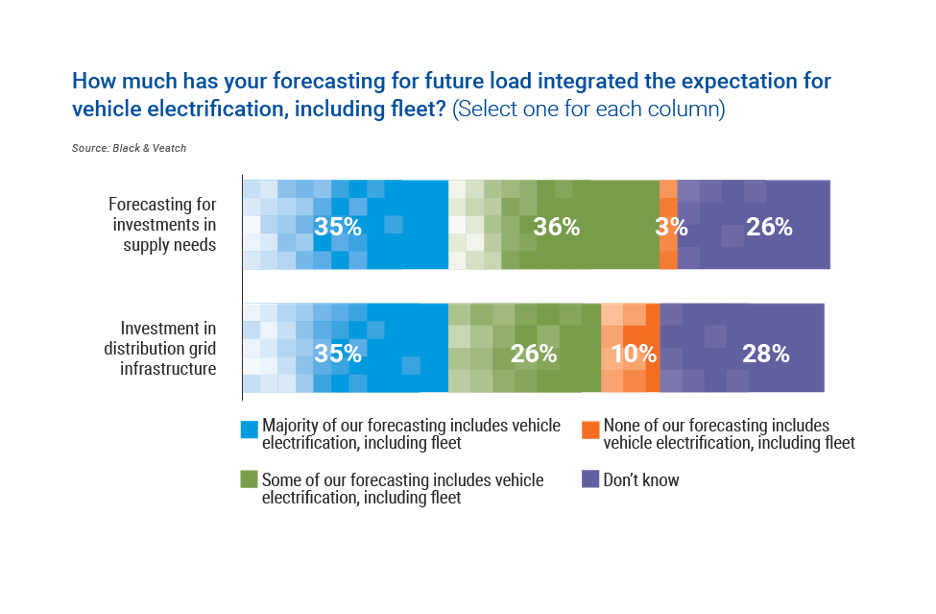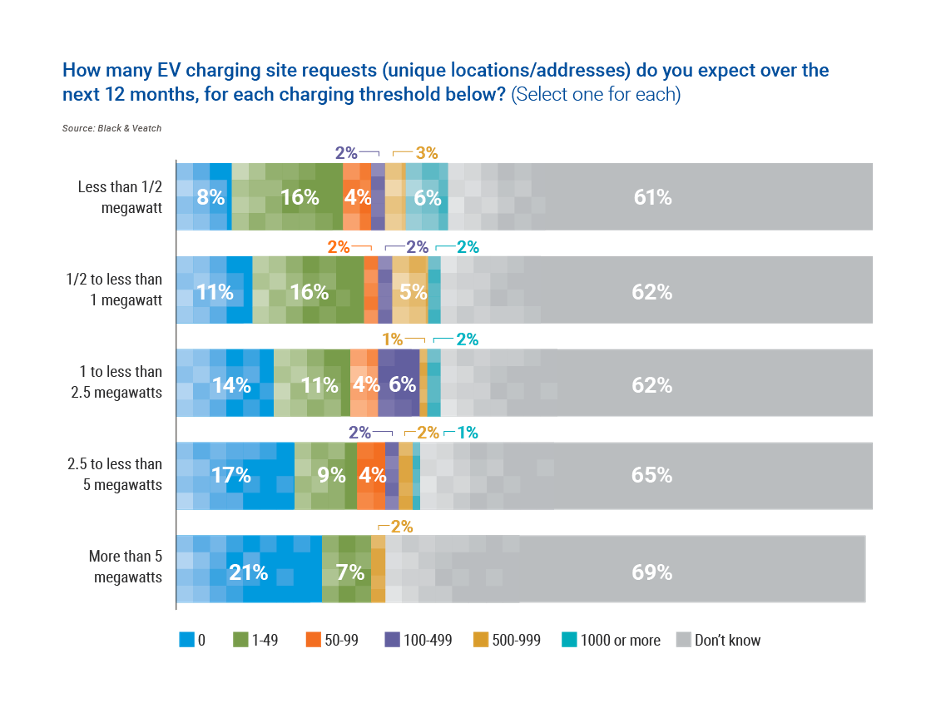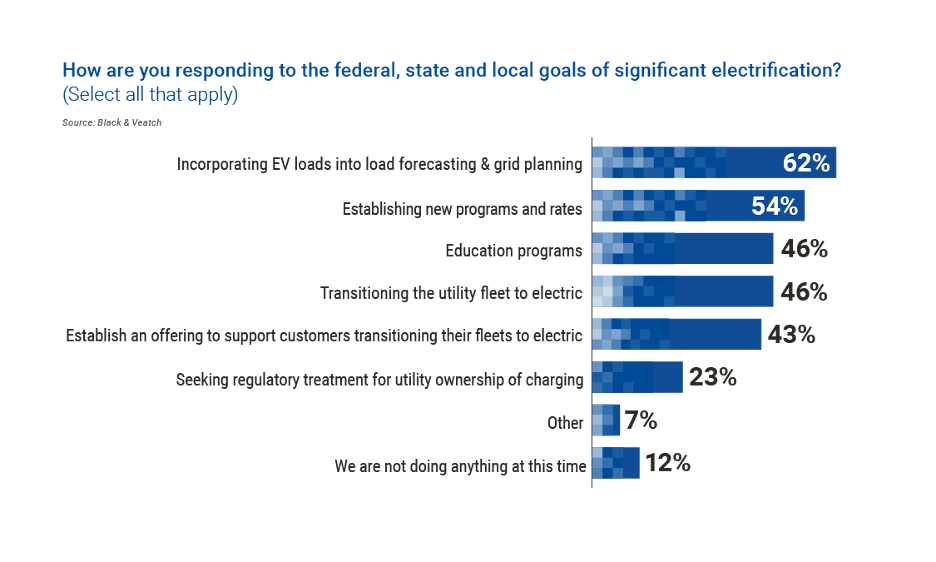As Vehicle Electrification Picks Up Speed, Electric Utilities Must Get in Gear
By The Black & Veatch Insights Group
As cars and trucks that run on fossil fuels contribute what the U.S. Department of Energy says amounts to 1.4 billion tons of greenhouse gas emissions into the atmosphere every year, the path forward is clear: electrify the vehicle industry.
Wagering that cleaner, quieter conveyances are the future, major car brands — from Japan-produced Toyotas to American-made Fords — have expanded their electric vehicle (EV) model lineups. Luxury market entrants from Tesla, Rivian and performance models from Porsche are seen as the new status of wealth.
So, are image and accessibility the only hurdles to overcome in the race to electrify transportation?
In April 2023, the U.S. Environmental Protection Agency proposed what, if finalized, amount to the most ambitious U.S. vehicle emissions reduction standards ever, meant to accelerate automakers’ shift to EVs. The plan expands the electrification of ridesharing, rental car and federal agency fleets and establishes community charging and more. While President Joe Biden and the auto industry are gearing up to electrify, are U.S. power suppliers ready for the increased demand for electricity?
Black & Veatch’s 2023 Electric Report — based on expert analysis of a survey of more than 650 U.S. electric sector stakeholders — paints a picture of an electric industry well aware that change is on the horizon but slow in making the necessary investments crucial to making it happen.
Forecasting the Future
The success of vehicle electrification is only as strong as the electric utilities that supply the load. Signed into law in late 2021, the federal, $1.2-trillion Bipartisan Infrastructure Law (BIL) aims for a net-zero emissions economy by 2050, with half of new U.S. car sales to be electric by the end of this decade. Funding upwards of $7.5 billion is earmarked for EV charging and infrastructure that communities across the country need to support the desired uptick in electrified fleets.
Uber, Lyft and Amazon, among other companies, are committing to transition their fleets to electric by 2030, just seven years from now, while federal agencies are chasing an ambitious 100-percent EV fleet as early as 2035. As companies and government agencies plan and prepare for the future, the assumption remains that electric utilities are doing the same.
When asked how much their enterprise’s forecasting of future load included the expectation for vehicle electrification, nearly two-thirds of respondents said that they were either unsure, only included some forecasting or did not forecast for it at all. That included forecasting for investments in supply needs as well as in distribution grid infrastructure.
Given the broad incentives in the BIL — and appealing and capable vehicles coming to market in all segments — this is money in the bank for utilities due to their selling considerably more of their product — the humble electron. The question remains when and how to share the benefits of future electrification revenue with all stakeholders via the promise of downward pressure rates.
With a 70/30 split between utilities adequately forecasting for the future vehicle electrification load and those who are not quite there yet, we can’t help but ask, “if not now, when?”
Mapping EV Charging Site Timelines
According to a 2022 whitepaper by National Grid, an investor-owned energy company serving more than 20 million people throughout New York and Massachusetts, a larger, highway-side charging station serving both personal EVs and heavy-duty battery electric trucks could need to provide up to 19 megawatts of electricity by 2035 — the same year the federal government aims for a 100-percent electric fleet. That’s roughly the same amount a small town uses.
Given this scale of charging and the roughly 11 years to this benchmark, the level of urgency should be seemingly high. When asked how many EV charging site requests are expected over the next 12 months, about two-thirds of respondents consistently said they didn’t know. Conversely, about one-third cited anywhere from zero to 1,000 or more requests in ranges from one-half of a megawatt to more than five megawatts. Notably, one in five respondents expect no charging site requests over five megawatts in the next year.
As noted in the National Grid example, the size and duty cycle of commercial fleet and large travel center facilities can range into tens of megawatts. Planning for and provisioning power at this magnitude can take years — even a decade — if serving the load requires new substations, transmission and distribution lines, real estate and associated right of ways.
Based on Black & Veatch’s knowledge, numerous requests for megawatt and larger sites are being submitted to utilities across the country. Examining the survey results, respondents either are not in a position to know about these requests and answered incorrectly or they simply are not seeing the new demand. Either scenario is alarming for triggering infrastructure planning efforts at the level needed.
Electrifying Early
With almost 70 percent of utilities seemingly unprepared and 30 percent in the early stages of planning, a common denominator has emerged: ready or not, electrification is here. While consumer adoption is driven by choice, commercial fleet trajectories follow regulatory considerations and economics. All indications are that electrification is the new normal, and the sooner organizations embrace the change, the more benefits they can accrue by design versus playing catch up later.
Many U.S. electric utilities are taking a proactive posture. When asked how they are responding to the federal, state and local goals of significant electrification, nearly half of the respondents said they are establishing new programs, rates and education programs while transitioning the utility fleet to electric. More than six in 10 respondents — 62 percent — are incorporating EV loads into load forecasting and grid planning. Only 12 percent replied that they are not doing anything at this time — a small enough group to evoke optimism and hope.
All told, the keys are making the most of the investment, market growth opportunity and catching up with other countries that have shown this can be done. Slowly but surely, the vehicle supply chain is getting resolved with huge investments, but the energy supply chain to power those vehicles is at risk without more thoughtful planning.
Utilities can both get ahead of the needs of communities and set themselves up for increased revenues and profits by intensifying their infrastructure planning and investments — or getting off the sidelines in the first place — as the pace of electrification picks up speed.




